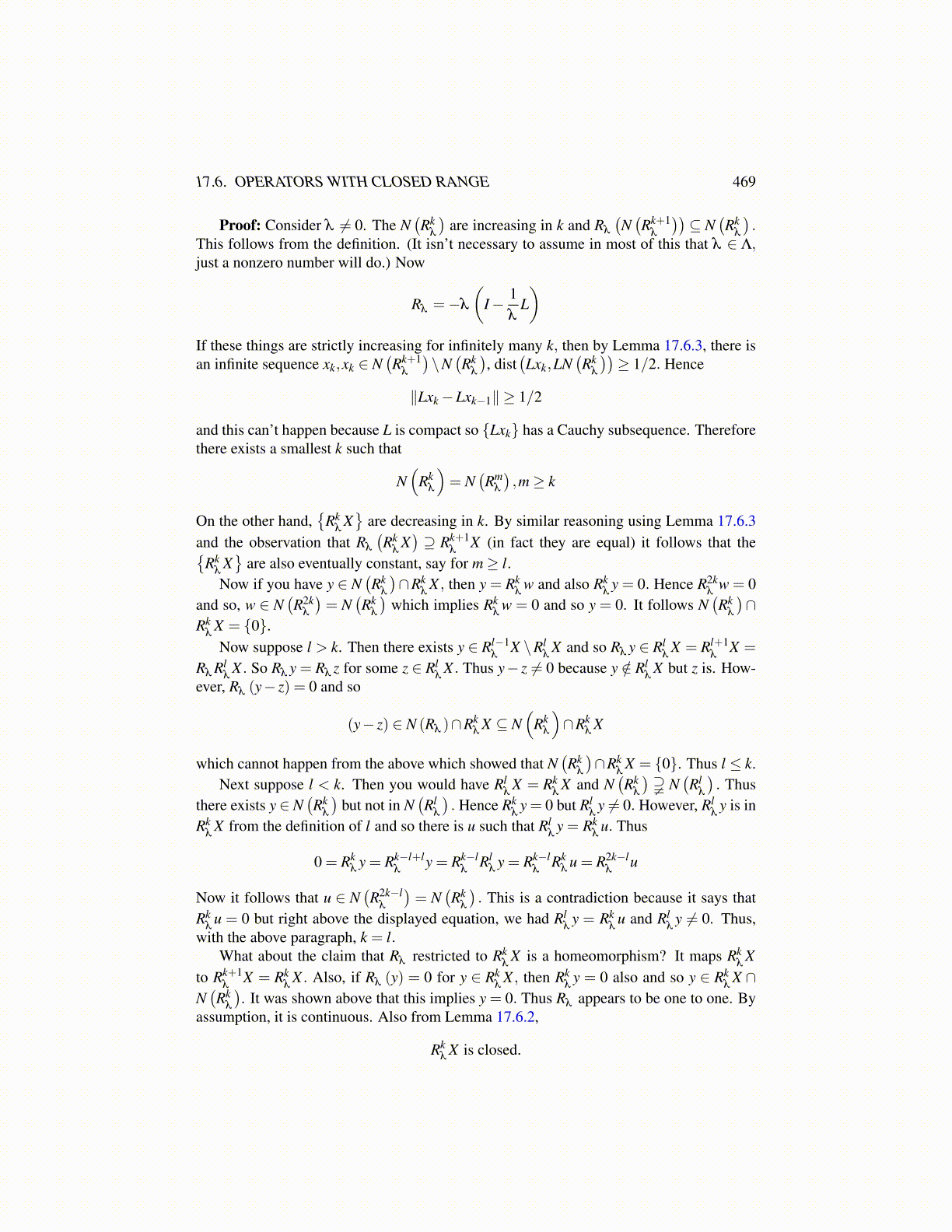
17.6. OPERATORS WITH CLOSED RANGE 469
Proof: Consider λ ̸= 0. The N(Rk
λ
)are increasing in k and Rλ
(N(Rk+1
λ
))⊆ N
(Rk
λ
).
This follows from the definition. (It isn’t necessary to assume in most of this that λ ∈ Λ,just a nonzero number will do.) Now
Rλ =−λ
(I− 1
λL)
If these things are strictly increasing for infinitely many k, then by Lemma 17.6.3, there isan infinite sequence xk,xk ∈ N
(Rk+1
λ
)\N(Rk
λ
), dist
(Lxk,LN
(Rk
λ
))≥ 1/2. Hence
∥Lxk−Lxk−1∥ ≥ 1/2
and this can’t happen because L is compact so {Lxk} has a Cauchy subsequence. Thereforethere exists a smallest k such that
N(
Rkλ
)= N
(Rm
λ
),m≥ k
On the other hand,{
Rkλ
X}
are decreasing in k. By similar reasoning using Lemma 17.6.3and the observation that Rλ
(Rk
λX)⊇ Rk+1
λX (in fact they are equal) it follows that the{
Rkλ
X}
are also eventually constant, say for m≥ l.Now if you have y ∈ N
(Rk
λ
)∩Rk
λX , then y = Rk
λw and also Rk
λy = 0. Hence R2k
λw = 0
and so, w ∈ N(R2k
λ
)= N
(Rk
λ
)which implies Rk
λw = 0 and so y = 0. It follows N
(Rk
λ
)∩
Rkλ
X = {0}.Now suppose l > k. Then there exists y ∈ Rl−1
λX \Rl
λX and so Rλ y ∈ Rl
λX = Rl+1
λX =
Rλ Rlλ
X . So Rλ y = Rλ z for some z ∈ Rlλ
X . Thus y− z ̸= 0 because y /∈ Rlλ
X but z is. How-ever, Rλ (y− z) = 0 and so
(y− z) ∈ N (Rλ )∩Rkλ
X ⊆ N(
Rkλ
)∩Rk
λX
which cannot happen from the above which showed that N(Rk
λ
)∩Rk
λX = {0}. Thus l ≤ k.
Next suppose l < k. Then you would have Rlλ
X = Rkλ
X and N(Rk
λ
)⫌ N
(Rl
λ
). Thus
there exists y ∈ N(Rk
λ
)but not in N
(Rl
λ
). Hence Rk
λy = 0 but Rl
λy ̸= 0. However, Rl
λy is in
Rkλ
X from the definition of l and so there is u such that Rlλ
y = Rkλ
u. Thus
0 = Rkλ
y = Rk−l+lλ
y = Rk−lλ
Rlλ
y = Rk−lλ
Rkλ
u = R2k−lλ
u
Now it follows that u ∈ N(R2k−l
λ
)= N
(Rk
λ
). This is a contradiction because it says that
Rkλ
u = 0 but right above the displayed equation, we had Rlλ
y = Rkλ
u and Rlλ
y ̸= 0. Thus,with the above paragraph, k = l.
What about the claim that Rλ restricted to Rkλ
X is a homeomorphism? It maps Rkλ
Xto Rk+1
λX = Rk
λX . Also, if Rλ (y) = 0 for y ∈ Rk
λX , then Rk
λy = 0 also and so y ∈ Rk
λX ∩
N(Rk
λ
). It was shown above that this implies y = 0. Thus Rλ appears to be one to one. By
assumption, it is continuous. Also from Lemma 17.6.2,
Rkλ
X is closed.